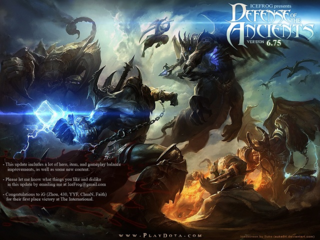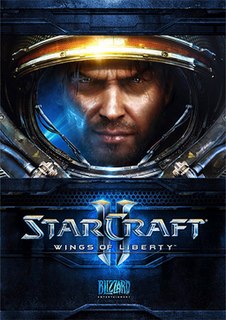Related Research Articles

Blizzard Entertainment, Inc. is an American video game developer and publisher based in Irvine, California. A subsidiary of Activision Blizzard, the company was founded on February 8, 1991, under the name Silicon & Synapse, Inc. by three graduates of the University of California, Los Angeles: Michael Morhaime, Frank Pearce and Allen Adham. The company originally concentrated on the creation of game ports for other studios' games before beginning development of their own software in 1993 with games like Rock n' Roll Racing and The Lost Vikings. In 1994, the company became Chaos Studios, Inc., and eventually Blizzard Entertainment after being acquired by distributor Davidson & Associates. Shortly thereafter, Blizzard released Warcraft: Orcs & Humans.

Warcraft III: Reign of Chaos is a high fantasy real-time strategy computer video game developed and published by Blizzard Entertainment released in July 2002. It is the second sequel to Warcraft: Orcs & Humans, after Warcraft II: Tides of Darkness, the third game set in the Warcraft fictional universe, and the first to be rendered in three dimensions. An expansion pack, The Frozen Throne, was released in July 2003. Warcraft III is set several years after the events of Warcraft II, and tells the story of the Burning Legion's attempt to conquer the fictional world of Azeroth with the help of an army of the Undead, led by fallen paladin Arthas Menethil. It chronicles the combined efforts of the Human Alliance, Orcish Horde, and Night Elves to stop them before they can corrupt the World Tree.

World of Warcraft (WoW) is a massively multiplayer online role-playing game (MMORPG) released in 2004 by Blizzard Entertainment. Set in the Warcraft fantasy universe, World of Warcraft takes place within the world of Azeroth, approximately four years after the events of the previous game in the series, Warcraft III: The Frozen Throne. The game was announced in 2001, and was released for the 10th anniversary of the Warcraft franchise on November 23, 2004. Since launch, World of Warcraft has had eight major expansion packs: The Burning Crusade (2007), Wrath of the Lich King (2008), Cataclysm (2010), Mists of Pandaria (2012), Warlords of Draenor (2014), Legion (2016), Battle for Azeroth (2018), and Shadowlands (2020).

Warcraft III: The Frozen Throne is the expansion pack for Warcraft III: Reign of Chaos, a real-time strategy video game by Blizzard Entertainment. It was released worldwide on July 1, 2003 for Microsoft Windows and Mac OS X. The Frozen Throne builds upon the story of Reign of Chaos and depicts the events after the main game's conclusion. The single-player unfolds from the perspective of two new protagonists—the Night Elf warden Maiev Shadowsong and the Blood Elf prince Kael'Thas—as well as returning protagonist Arthas Menethil. Additionally, the expansion contains Act I of a separate Horde campaign that is independent from the main storyline with Blizzard releasing Acts II and III via patch in December 2003, taking in player feedback of Act I when developing these chapters.
Warcraft is a franchise of video games, novels, and other media created by Blizzard Entertainment. The series is made up of five core games: Warcraft: Orcs & Humans, Warcraft II: Tides of Darkness, Warcraft III: Reign of Chaos, World of Warcraft, and Hearthstone. The first three of these core games are in the real-time strategy genre, where opposing players command virtual armies in battle against each other or a computer-controlled enemy. The fourth and best-selling title of the franchise is a massively multiplayer online role-playing game (MMORPG), where players control their character and interact with each other in a virtual world. Warcraft is one of the highest-grossing video game franchises of all time, having grossed $11.2 billion in lifetime revenue, as of 2018.

Warcraft II: Beyond the Dark Portal is an expansion pack for the real-time strategy video game Warcraft II: Tides of Darkness for Microsoft Windows and Macintosh. It was developed by Blizzard Entertainment and Cyberlore Studios, and published by Blizzard in North America and Europe in 1996. It requires the full version of the original game to run and adds new story campaigns and multiplayer maps. The expansion was later released alongside Tides of Darkness for the PlayStation and Sega Saturn in 1997 as Warcraft II: The Dark Saga, and was included in the Warcraft II: Battle.net Edition for Windows PC and Macintosh in 1999.

Defense of the Ancients (DotA) is a multiplayer online battle arena (MOBA) mod for the video game Warcraft III: Reign of Chaos (2002) and its expansion, The Frozen Throne. The objective of the game is for each team to destroy their opponents' Ancient, a heavily guarded structure at the opposing corner of the map, which is based on the "Aeon of Strife" map for StarCraft. Players use powerful units known as heroes, and are assisted by allied teammates and AI-controlled fighters. As in role-playing games, players level up their heroes and use gold to buy equipment during the mission.

Sam "Samwise" Didier is the Senior Art Director at Blizzard Entertainment. As the art director for the flagship games of the Warcraft, StarCraft, and Diablo franchises, the producer of several games, and an artistic contributor to almost every game released under the name Blizzard Entertainment, Didier has created a distinctive Blizzard house style. Edge described Didier's style as "a striking, pulp sensibility that may be an acquired taste, but one acquirable on either side of the Pacific, side-stepping polarisation of appeal to either eastern or western audiences." His other contributions to Blizzard projects include writing, voice acting, music, sculpture, the Pandaren species, and the name "Warcraft". Leonardo Marcato calls him "one of the game designers that can be legitimately called authors thanks to the imprint they gave to projects they directed."

Christopher Vincent Metzen a.k.a. "Thundergod" is an American game designer, artist, voice actor, and author known for his work creating the fictional universes and scripts for Blizzard Entertainment's three major award-winning media franchises: Warcraft, Diablo and StarCraft. On occasion, Metzen has published his art under the alias "Thundergod". Metzen was hired by Blizzard Entertainment as an animator and an artist; his first work for the company was with the video game Justice League Task Force.

Bill Roper is Chief Creative Officer at Improbable. Previously, he was Vice President/GM at Disney Interactive Studios since June 2011, and headed video game studios and creative and development departments for two decades, including divisions at Blizzard Entertainment, Flagship Studios, and Cryptic Studios. He is also an accomplished musician, and a founding member of the folk band The Poxy Boggards.

Rob Pardo is the former Chief Creative Officer at Blizzard Entertainment, resigning on July 3, 2014. Previously he was the Executive Vice President of Game Design at Blizzard Entertainment, and prior to that the lead designer of World of Warcraft. In 2006, he was named by Time Magazine as one of the 100 most influential people in the world.

Jeffrey Kaplan is an American video game designer who is vice president of Blizzard Entertainment. He designed elements of World of Warcraft and is the lead designer on Overwatch.

StarCraft II: Wings of Liberty is a science fiction real-time strategy video game developed and published by Blizzard Entertainment. It was released worldwide in July 2010 for Microsoft Windows and Mac OS X. A sequel to the 1998 video game StarCraft and the Brood War expansion pack, the game is split into three installments: the base game, subtitled Wings of Liberty, an expansion pack, Heart of the Swarm, and a stand-alone expansion pack, Legacy of the Void. In March 2016, a campaign pack called StarCraft II: Nova Covert Ops was released.

Battle.net is an Internet-based online game, social networking service, digital distribution, and digital rights management platform developed by Blizzard Entertainment. Battle.net was launched on December 31, 1996, followed a few days later with the release of Blizzard's action-role-playing video game Diablo on January 3, 1997.

Illidan Stormrage is a fictional character who appears in the Warcraft series of video games by Blizzard Entertainment. Born a night elf and sorcerer, his pursuit of power led him to commit several horrific acts against his own people, which earned him the nickname "the Betrayer" and to become the first Demon Hunter. Self-proclaimed the Lord of Outland, he also defected to the Burning Legion and became a partial demon himself. Illidan also appears as a playable character in the crossover multiplayer online battle arena game Heroes of the Storm. The character is one of the most notable and popular in the Warcraft franchise and has received positive critical reception from video game players. Illidan was voiced by Matthew Yang King in Warcraft III: Reign of Chaos and its expansion The Frozen Throne, and by Liam O'Brien since World of Warcraft: The Burning Crusade.

Warcraft II: Tides of Darkness is a fantasy real-time strategy computer game developed by Blizzard Entertainment and released for DOS in 1995 and Mac OS in 1996 by Blizzard's parent, Davidson & Associates. It's a sequel to Warcraft: Orcs & Humans. The game was met with positive reviews and won most of the major PC gaming awards in 1996. In 1996, Blizzard released an expansion pack, Warcraft II: Beyond the Dark Portal, for DOS and Mac OS, and a compilation, Warcraft II: The Dark Saga, for the PlayStation and Sega Saturn. The Battle.net edition, released in 1999, provided Blizzard's online gaming service, and replaced the MS-DOS version with a Windows one.
Multiplayer online battle arena (MOBA) is a subgenre of strategy video games in which two teams of players compete against each other on a predefined battlefield. Each player controls a single character with a set of unique abilities that improve over the course of a game and which contribute to the team's overall strategy. The ultimate objective is for each team to destroy their opponents' main structure, located at the opposite corner of the battlefield. However, MOBA games can have other victory conditions, such as defeating every player on the enemy team. Players are assisted by computer-controlled units that periodically spawn in groups and march forward along set paths toward their enemy's base, which is heavily guarded by defensive structures. This type of multiplayer online video games originated as a subgenre of real-time strategy, though MOBA players usually do not construct buildings or units. Moreover, there are examples of MOBA games that are not considered real-time strategy games, such as Smite (2014), and Paragon. The genre is seen as a fusion of real-time strategy, role-playing, and action games.

Sylvanas Windrunner is a fictional character who appears in the Warcraft series of video games by Blizzard Entertainment. Originally introduced in Warcraft III: Reign of Chaos, she received a dramatic redesign in World of Warcraft: Legion to her current appearance, much more in line with her in-universe lore depictions. Once a high elf ranger-general of Silvermoon, Sylvanas was murdered by Arthas Menethil when she led a doomed resistance against his invasion. In one climactic battle, that left the capital city of Silvermoon in ruins, he managed to finally beat the elven general, ripping her soul out and transforming her into a banshee. This newest agent of the Lich King was empowered by hatred of the living and an everlasting desire to rule over her new brethren. In The Frozen Throne, Sylvanas was able to regain her free will and body and founded the Forsaken faction of undead while styling herself as the "Banshee Queen" and "Dark Lady". With her new undead forces vowing to take revenge on the Lich King, they set out to wage war against the Scourge. As of World of Warcraft's patch 7.0.3, she is also the incumbent Warchief of the Horde, standing as one of the most powerful political leaders in all of Azeroth following the death of Vol'jin.
Dota is a series of strategy video games by Valve. The series began in 2003 with the release of Defense of the Ancients (DotA), a fan-developed multiplayer online battle arena (MOBA) mod for the video game Warcraft III: Reign of Chaos and its expansion, The Frozen Throne. The original mod features gameplay centered around two teams of up to five players who assume control of individual characters called "heroes", which must coordinate to destroy the enemy's central base structure called an "Ancient", to win the game. Ownership and development of DotA was passed on multiple times since its initial release, until Valve hired the mod's final developer and after an ongoing legal dispute with Blizzard Entertainment, the developer of Warcraft III, brokered a deal that allowed for Valve to inherit the Dota name trademark.

WarCraft III: Reforged is a remastered edition of the 2002 real-time strategy video game WarCraft III: Reign of Chaos and its expansion The Frozen Throne. Released on January 28, 2020, it adds revamped graphics, new campaign gameplay settings as well as modern online Battle.net features. The game received mixed reviews from critics and an overwhelmingly negative reception from players for its changes from the original, the lack of many features, and technical issues.
References
- ↑ Boxer, Steve (2002-06-11). "War Craft III: Reign of Chaos". The Guardian . Retrieved 2009-01-16.
- ↑ Cottee, James (2003-07-02). "Warcraft III Expansion: The Frozen Throne". The Age . Retrieved 2009-01-16.
- ↑ Cohen, Peter (2002-12-01). "The Game Room: Let Chaos Reign". Macworld . Retrieved 2009-01-16.
- ↑ Walbridge, Michael (2009-01-16). "Analysis: Defense of the Ancients - An Underground Revolution". Gamasutra . Retrieved 2008-06-23.
- ↑ "Blizzard Ships Warcraft III: The Frozen Throne". GamePro. 2003-06-01. Archived from the original on 2009-02-17. Retrieved 2009-01-16.